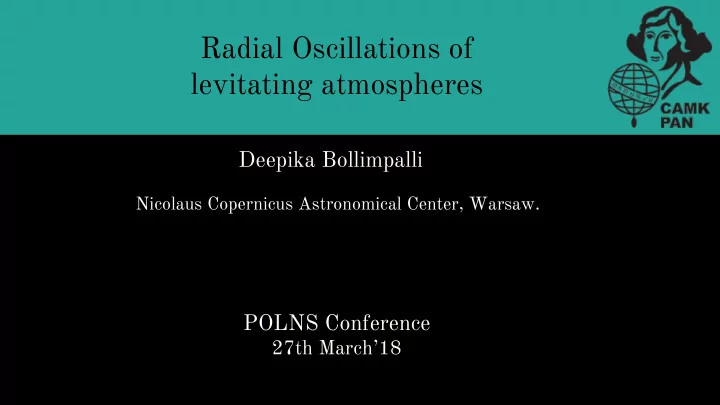

Radial Oscillations of levitating atmospheres Deepika Bollimpalli Nicolaus Copernicus Astronomical Center, Warsaw. POLNS Conference 27th March’18
Levitating atmospheres ● Likely formed in neutron stars with Super-Eddington luminosity Gravity Radiation pressure M NS In Newtonian Theory, gravity and radiation force fall of as 1/r 2 , whereas in General theory of Relativity, both have a different radial dependence.
Levitating atmospheres ● Likely formed in neutron stars with Super-Eddington luminosity Gravity Radiative 2M r 0 = force M 1- λ 2 NS λ is the Eddington parameter r 0 r 0 In Newtonian Theory, gravity and radiation force fall of as 1/r 2 , whereas in General theory of Relativity, both have different radial dependence.
Levitating atmospheres - Hydrostatic equilibrium ● We assume a static, spherically symmetric spacetime , where ● Continuity equation Optically thin limit ● Euler equation ● Hydrostatic equilibrium
Polytropic atmospheres ● We assume polytropic equation of state, ● Background solution,
Analytical approach Fluid variables : � X = X(r)e i � t � r r 0 Continuity Differential equation/ Eigenvalues/ & NS Eigenvalue problem Eigenfrequencies Euler equations = Trick is
Eigenvalue problem ● Imaginary part yields which gives the damping coefficient, ● Real part of the eigenvalue problem is a Gegenbauer differential equation and the Gegenbauer relation gives,
Undamped Oscillations ( � =0) ● Frequency of an eigenmode ● Ratio of breathing mode frequency to the fundamental mode frequency
Undamped frequencies Undamped frequencies of the ten first normal modes of the thin atmospheres as a function of the atmosphere location
Radial Oscillations
Damped Oscillations ● Underdamped > 0 > ● Critically damped ● Overdamped
Damped frequencies Damped frequencies of the ten first normal modes of the thin atmospheres as a function of the atmosphere location Critically damped
Observational interests ● For a given λ or r 0 , the frequency of the mode increases with the number and most of the frequencies of these oscillations are in the desirable range of 300-600 Hz observed for the frequencies of oscillations during Type I X-ray bursts. ● These oscillations could also have applications to the ULX systems with neutron stars that often attain their super-Eddington luminosities due to accretion process. ● Levitating atmospheres can deflect the light rays coming from the central compact source and this can significantly affect the appearance of the central object in the observations ( Rogers et. al. 2017 ). ● An analogue of these atmospheres had been found to occur in the coronae of the accretion disks ( Fukue 1996 ).
Recommend
More recommend